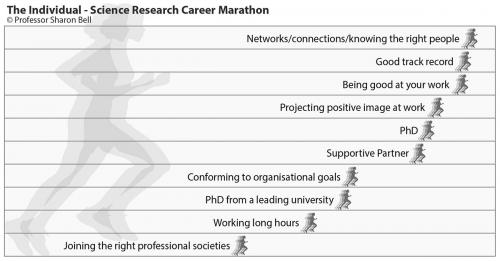The issue of under-representation of women at senior levels in science research has been studied for many years both in Australia and internationally. Women usually leave the science research workforce for either structural or cultural reasons.
The structure of an academic system is such that it rewards those who are able to work full time (frequently with workloads requiring well over 40 hours a week) for a continuous period, with extensive networking through conferences involving multiple days and long-distance travel.
A critical period of a woman’s academic career, the transition from postdoctoral appointments to a substantive position, is likely to coincide with the time when she may decide to have children. However, academic demands don’t satisfactorily accommodate maternity leave, part-time work, flexible hours or limited ability to travel. Traditional family roles allow men more than women to undertake such work patterns.
Cultural reasons for the loss of women from science research are more subtle and complex. Unconscious bias has been identified as a fundamental cause of the loss of women from science research positions. This is the bias that leads to identical resumés or online courses being judged more positively when they are thought to originate from men. It results in negative judgements of women for confident and assertive behaviour, the same behaviour for which men would be admired or rewarded.
Subtle yet pervasive consequences of unconscious bias include not inviting women to speak at conferences or to serve on committees or in other responsible roles. It can mean that women are not provided with important information that is given through informal channels.
A further cultural aspect is the recognised tendency to appoint in one’s own image, which means that existing predominantly male hierarchies have an inherent inertia. The knock-on effects of these small but cumulative gendered practices on promotion, collaboration and academic success result in the situation illustrated in the so-called scissors graph, shown here for all natural and physical sciences in Australia.
Women in the science research workforce: the scissor effect
The finding, that the proportion of women drops significantly over the progression from undergraduate study through the academic levels was one outcome of a recent, comprehensive study led by Sharon Bell and Lyn Yates and funded by an ARC Linkage Grant (2011–14). The study investigated gendered career paths and critical career transitions in chemistry and biology in Australia, using a combination of surveys, focus groups and analysis of existing data sets (full report at bit.ly/1MjI5NV). The RACI was an industry partner on the grant and CEO Roger Stapleford contributed to the project.
The point at which the scissors diverge, that is the career stage at which the proportion of men increases, has moved backwards in recent years: in 2007, women held more level A (the lowest level substantive academic role) positions than men, but this has now been reversed. Although analogous data specific to chemistry has not been gathered separately, the situation in our discipline very likely parallels that shown.
The loss of women from the science research workforce is a complex problem that defies simple remedies. As Bell and Yates and others have identified, the solution requires cultural change on the part of institutions as well as changes to employment practices. Bell and Yates characterise the academic workforce as a marathon, in which multiple factors combine over many years to lead to success. Specific strategies that have been shown to improve the proportion of women in academic positions include requiring a balance of women and men to sit on selection and promotion committees, requiring formal and transparent processes for all decisions that affect seniority and funding, and providing mandatory training in the manifestations and consequences of unconscious bias.
As part of their ARC project, Bell and Yates have developed a website that includes a toolkit (bit.ly/1kuIqCt) aimed at senior leaders, team leaders and individuals (see images). This toolkit provides information to understand the cultural shift required from scientists and senior management to reduce the loss of women from science research positions.
The Athena SWAN charter
In the UK, the Athena SWAN charter was launched in 2005 to advance the career progression of women in science at UK universities. The charter is run by the Equality Challenge Unit, a charity funded by a group of representative and funding bodies in higher education in the UK. The ten principles of the Athena SWAN charter (bit.ly/1MjJnsc) can be summarised as a commitment to the following major goals:
- advancing gender equality in academia, in particular, addressing the loss of women across the career pipeline and the absence of women from senior academic, professional and support roles
- tackling the gender pay gap (Note that in Australia this is also a federal requirement under the Workplace Gender Equality (Minimum Standards) Instrument 2014 of the Workplace Gender Equality Act 2012.)
- removing the obstacles faced by women, in particular, at major points of career development and progression, including the transition from PhD into a sustainable academic career
- addressing the negative consequences of using short-term contracts for the retention and progression of staff in academia
- making and mainstreaming sustainable structural and cultural changes to advance gender equality, recognising that initiatives and actions that support individuals alone will not sufficiently advance equality.
When institutions sign up to Athena SWAN, they commit to the ten principles. Once an institution has joined, both the whole institution and its departments can apply for Athena SWAN awards. These are awarded on the basis of performance at bronze, silver and gold levels. The criteria examine:
- academic staff career transition points (recruitment, promotion, those selected for research quality assessment exercises)
- career development
- flexible working and career breaks (including maternity and paternity leave)
- organisation and culture (including proportion of women in senior management, workload model).
There are currently 134 Athena SWAN institutional members and 483 award holders in the UK, and the program was recently launched in Ireland.
A preliminary review of the impact of Athena SWAN was conducted after five years of operation and found significant improvement in the percentage of women at all academic levels in several institutions; comparative data could not be obtained due to changes in reporting details (bit.ly/1Wxr35s). A more detailed study into the impact of Athena SWAN membership and awards was undertaken in 2013 (bit.ly/1MBdUgS). It was found that membership does impact positively on the culture of institutions, particularly if senior management is committed to change. A full statistical analysis of the impact of Athena SWAN after ten years of operation is underway and will be published in 2016.
The UK National Institute for Health Research (equivalent to the NHMRC) has instituted a requirement for an Athena SWAN Silver award for several of its funding schemes, amounting to approximately 25% of total funding awarded by the NIHR. This requirement will first be applied in the upcoming funding rounds starting in 2016.
Science in Australia Gender Equity
In November 2014, the Australian Academy of Sciences hosted a Science in Australia Gender Equity (SAGE) Forum with around 140 stakeholders to discuss the best approaches to improve gender equity in STEM (science, technology, engineering and mathematics). Up until that point, no national strategy to improve gender equity in STEM existed. It was agreed by the participants that concerted action across the sector is required, and the approach chosen was to trial the Athena SWAN charter in Australia. This was launched in September 2015. Prior to this national approach, some individual institutions already had established gender equity programs including the Walter and Eliza Hall Institute of Medical Research (bit.ly/1kcbhvY). The discipline of engineering had also already released a comprehensive strategy to improve gender equity across their industry (bit.ly/1MJE8UE). However, chemistry was not involved in any such strategy and the RACI has no gender equity statement or policy similar to that of the Australian Academy of Technological Sciences and Engineering (bit.ly/1MBe8oe).
The pilot of Athena SWAN in Australia is being overseen by the Australian Academy of Sciences. The 32 institutions involved (bit.ly/1P0NAOw) are required to collect data on their current gender equity status, practices and policies, to identify areas of potential improvement and to implement action plans to improve gender equity for their staff.
The process begins with the appointment of a self-assessment team, which meets and puts together the data required for application for membership. Each institution is expected to develop their own action plan for improvement as part of their application. The team has the on-going task of monitoring implementation of the action plan, including how it will interact with other relevant committees and structures within the institution.
The actions suggested by Athena SWAN to improve gender equity in STEM encompass all aspects of academic life.
Recruitment processes: Women (and men where underrepresented) should be explicitly encouraged to apply. Recruitment panels should have a gender balance (not a token woman) and should be trained, including on the existence of unconscious bias.
Promotions: Identification of candidates and communication of the process and criteria should explicitly target women. The criteria for promotion should include the full range of work-related activities (including administrative, pastoral and outreach work) and should be sensitive to the impact of career breaks. Training or mentoring should be offered around promotion and the process should be transparent and fair.
Flexible working: Arrangements should support staff who may need to change their working patterns. A formal, institutional-level approach should cover absences of staff who take extended absence rather than relying on their colleagues. This should include arrangements to enable staff to keep in touch during leave, and to support staff before and upon their return to work. Managers should be supported in managing flexible working arrangements and the options available should be communicated to all staff. Staff transitioning from part-time to full-time work should be supported with mentoring or coaching support and a phased increase in workload or working pattern. The timing of meetings and social gatherings should consider those with caring responsibilities and part-time staff.
Child care: Child care with extended opening times and sufficient places should be provided at institutions.
Culture: Consistent HR policies about equality, dignity at work, bullying, harassment, grievance and disciplinary processes should be enacted. Any identified differences between policy and practice should be addressed. Staff with management responsibilities should be up to date in their HR knowledge.
Senior roles: Heads of schools, faculties or departments should be decided by a transparent process. Any specific gender underrepresentation should be addressed. Targeted support or leadership training should be provided for potential future senior managers to improve any gender imbalance on committees; role rotation, deputising and shadowing can be used as well as increasing the size of the committee if necessary.
Workload model: This should include teaching, pastoral, administrative and outreach responsibilities. It should be fair and transparent, and periodically reviewed by a gender-balanced committee.
Events: Gender equality should be built into organisation of events. This includes speakers and chairs in seminars, workshops and other relevant activities.
Outreach activities: While it is important to have underrepresented groups involved in outreach, often people from these groups end up doing a lot of outreach, which can affect other parts of their job, particularly research. Outreach should be formally recognised and included in workload modelling.
Action plans for Athena SWAN should be SMART (specific, measurable, achievable, relevant and time-bound) and prioritised, and responsibility for completing actions should be distributed across a range of staff.
Diverse groups in research have been shown to lead improved outcomes compared with homogeneous groups. The Australian model of Athena SWAN should benefit Australian research as well as individual women in their research careers.
On 7 December 2015 the federal government announced that it will support the expansion of the SAGE pilot to cover more Australian science and research institutions. This funding is part of a total $13 million to be spent over five years on several initiatives to encourage more women to choose and stay in STEM research, careers, startups and entrepreneurial firms.







